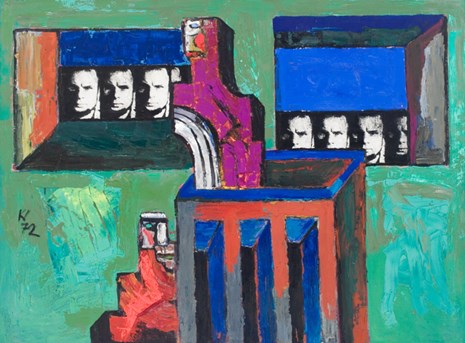Vincas Kisarauskas was an experimenter, an innovator, who sought to include the viewer in the process of actively perceiving a work of art. He himself also enjoyed participating in his self-created situations, like an actor or a prompter, or like a witness to the event.
In Seven and a Half Self-Portraits, the artist appears in six-and-a-half photographic portraits. The self-portrait functions as a sign of the artist's presence side-by-side. Kisarauskas manipulates the illusion of depth and plane, in order to challenge the viewer. The space in the painting is narrow and enclosed. The opportunity to move to other realities or spaces is opened up by the niches cutting into the masonry walls. Reading the meanings of the individual details is up to the perceiver's imagination. This is very important, as a different understanding of a detail alters the meaning of the entire picture. The perceiver of this work is included in a kind of game.
If we look at the geometric structure in the foreground of the painting, it recalls both an architectural detail and a stand. The vertical elements in the front part of it can be read as both protruding abutments and as open niches revealing the empty interior of the structure. The artist's predilection for manipulating the plane and the illusion of space is the result of his deep knowledge of the history of Western painting. His art is not based on the study of nature, but on his cultural experience.
Where is the seventh self-portrait of the artist? Take another look: there is one more character hiding at the foot of the cathedral, wearing a mask of the artist's self-portrait.



